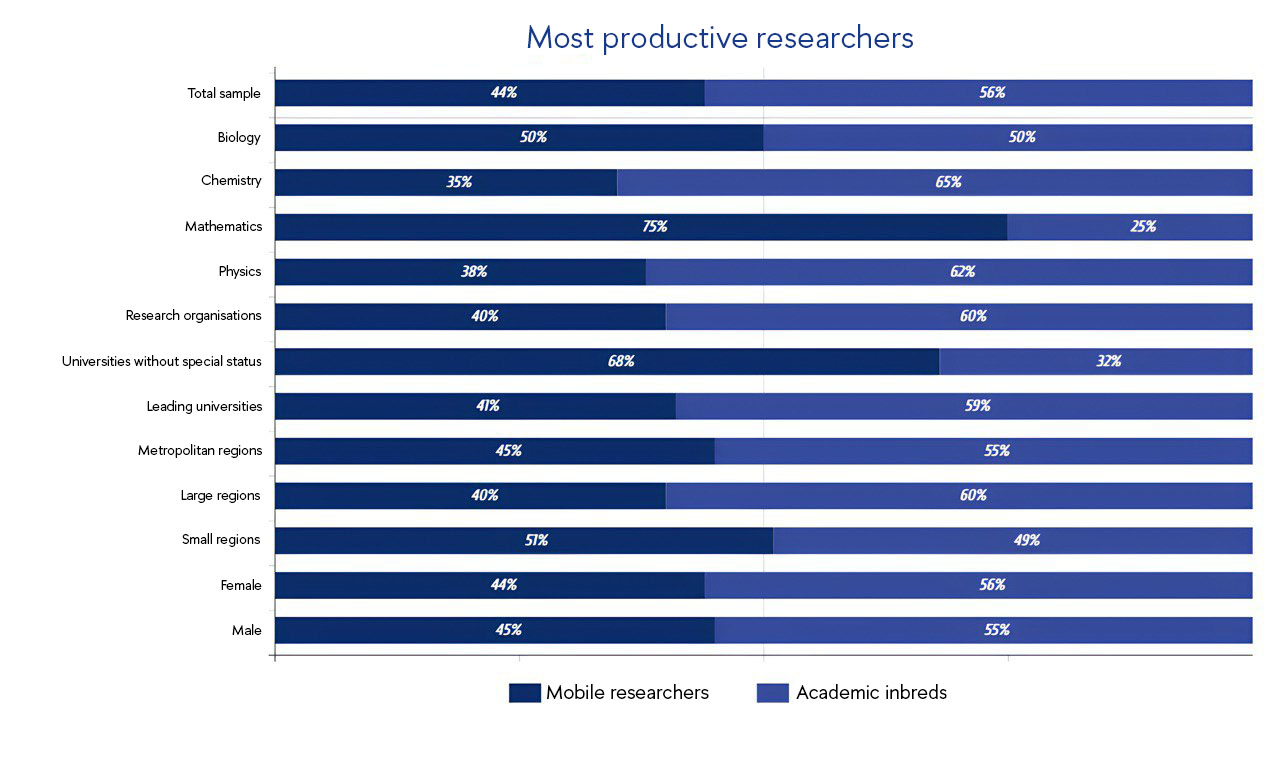HSE Scientists Reveal How Staying at Alma Mater Can Affect Early-Career Researchers

Many early-career scientists continue their academic careers at the same university where they studied, a practice known as academic inbreeding. A researcher at the HSE Institute of Education analysed the impact of academic inbreeding on publication activity in the natural sciences and mathematics. The study found that the impact is ambiguous and depends on various factors, including the university's geographical location, its financial resources, and the state of the regional academic employment market. A paper with the study findings has been published in Research Policy.
In Russia, nearly half of all PhD holders continue working at the same university where they earned their degree—a career path known as academic inbreeding. This practice is believed to contribute to academic isolation and diminish the potential for innovation. Nevertheless, the impact of academic inbreeding on the productivity of early-career scientists remains insufficiently studied.
Victoria Slepyh, Junior Research Fellow at the HSE Laboratory for University Development, examined the career trajectories of 1,132 Russian scientists who earned their PhDs in 2012 in the fields of physics, biology, chemistry, and mathematics. To assess research productivity, the author analysed publications in international journals, their citation counts, and the presence of articles in first-quartile (Q1) journals.
The analysis was conducted on two levels. First, the author examined all 1,132 PhD holders who remained in academia during the first eight years following their dissertation defence. Among this group, the rate of academic inbreeding was 61%. The results showed that graduates who moved to different universities after earning their degrees were, on average, more likely to publish, have articles accepted in prestigious journals, and receive higher citation counts compared to those who remained at their alma mater.
The most pronounced negative effect of academic inbreeding was observed at universities without special status—those not designated as federal or national research universities and not participating in government science support programmes. Early-career researchers at such universities published, on average, 34% fewer articles indexed by Scopus, and their likelihood of having at least one publication in a prestigious journal was nearly half that of more mobile scientists.
According to the author, if an early-career researcher remains at a university with limited scientific activity and resources, they tend to reproduce low academic standards. Moreover, a limited professional experience reduces their competitiveness compared to their more mobile colleagues.
'In prestigious, research-oriented institutions, academic inbreeding generally does not have a significant impact on productivity. This can be attributed to a rich professional environment, including a strong research team, modern equipment, stable collaborations with other organisations, and involvement in major projects,' explains Slepykh.
Next, the author identified a subgroup of the most productive scientists—417 individuals whose number of publications exceeded the median (ranging from four to six publications during the first eight years of their academic careers). The proportion of inbreds was 56% in this sample. At the same time, the impact of academic inbreeding on productivity within this subgroup was minimal and appeared only in certain cases—specifically, among graduates who earned their degrees in regions with a saturated academic employment market.
In regions with numerous scientific institutions, graduates have greater opportunities to move to a different employer. When remaining at one’s alma mater under such circumstances stems from inertia rather than a deliberate choice, early-career researchers may miss the opportunity to thrive in a more suitable professional environment. In less developed regions, academic inbreeding is typically driven by limited alternatives. The study findings support the hypothesis that when early-career scientists have more employment options, remaining at their alma mater can negatively affect their productivity.


Additionally, the study revealed differences in behaviour across scientific disciplines. For example, mathematicians were more likely to pursue mobile career paths and less likely to remain at the universities where they earned their degrees, whereas physicists and chemists exhibited a stronger tendency toward academic inbreeding. The author attributes these differences to the nature of research infrastructure and publication traditions in various scientific fields.
'Academic inbreeding, in itself, is not necessarily problematic. However, its consequences can adversely affect scientific productivity, especially at universities without special status or with limited resources. To mitigate the risks of isolation, measures should be implemented to encourage academic mobility and the expansion of external collaborations. These may include internships, academic exchanges, and the development of partnerships with leading research centres. Such initiatives will enhance not only productivity but also the overall quality of the academic environment,' according to Slepykh.
See also:
Scientists Develop Effective Microlasers as Small as a Speck of Dust
Researchers at HSE University–St Petersburg have discovered a way to create effective microlasers with diameters as small as 5 to 8 micrometres. They operate at room temperature, require no cooling, and can be integrated into microchips. The scientists relied on the whispering gallery effect to trap light and used buffer layers to reduce energy leakage and stress. This approach holds promise for integrating lasers into microchips, sensors, and quantum technologies. The study has been published in Technical Physics Letters.
HSE Scientists Test New Method to Investigate Mechanisms of New Word Acquisition
Researchers at the HSE Centre for Language and Brain were among the first to use transcranial alternating current stimulation to investigate whether it can influence the acquisition of new words. Although the authors of the experiment have not yet found a link between brain stimulation and word acquisition, they believe that adjusting the stimulation parameters may yield different results in the future. The study has been published in Language, Cognition and Neuroscience.
Twenty vs Ten: HSE Researcher Examines Origins of Numeral System in Lezgic Languages
It is commonly believed that the Lezgic languages spoken in Dagestan and Azerbaijan originally used a vigesimal numeral system, with the decimal system emerging later. However, a recent analysis of numerals in various dialects, conducted by linguist Maksim Melenchenko from HSE University, suggests that the opposite may be true: the decimal system was used originally, with the vigesimal system developing later. The study has been published in Folia Linguistica.
Scientists Rank Russian Regions by Climate Risk Levels
Researchers from HSE University and the Russian Academy of Sciences have assessed the levels of climate risks across Russian regions. Using five key climate risks—heatwaves, water stress, wildfires, extreme precipitation, and permafrost degradation—the scientists ranked the country’s regions according to their need for adaptation to climate change. Krasnoyarsk Krai, Irkutsk Region, and Sverdlovsk Region rank among the highest for four of the five climate risks considered. The study has been published in Science of the Total Environment.
HSE Researchers Teach Neural Network to Distinguish Origins from Genetically Similar Populations
Researchers from the AI and Digital Science Institute, HSE Faculty of Computer Science, have proposed a new approach based on advanced machine learning techniques to determine a person’s genetic origin with high accuracy. This method uses graph neural networks, which make it possible to distinguish even very closely related populations.
HSE Economists Reveal the Secret to Strong Families
Researchers from the HSE Faculty of Economic Sciences have examined the key factors behind lasting marriages. The findings show that having children is the primary factor contributing to marital stability, while for couples without children, a greater income gap between spouses is associated with a stronger union. This is the conclusion reported in Applied Econometrics.
Fifteen Minutes on Foot: How Post-Soviet Cities Manage Access to Essential Services
Researchers from HSE University and the Institute of Geography of the Russian Academy of Sciences analysed three major Russian cities to assess their alignment with the '15-minute city' concept—an urban design that ensures residents can easily access essential services and facilities within walking distance. Naberezhnye Chelny, where most residents live in Soviet-era microdistricts, demonstrated the highest levels of accessibility. In Krasnodar, fewer than half of residents can easily reach essential facilities on foot, and in Saratov, just over a third can. The article has been published in Regional Research of Russia.
HSE Researchers Find Counter-Strike Skins Outperform Bitcoin and Gold as Alternative Investments
Virtual knives, custom-painted machine guns, and gloves are common collectible items in videogames. A new study by scientists from HSE University suggests that digital skins from the popular video game Counter-Strike: Global Offensive (CS:GO) rank among the most profitable types of alternative investments, with average annual returns exceeding 40%. The study has been published in the Social Science Research Network (SSRN), a free-access online repository.
HSE Neurolinguists Reveal What Makes Apps Effective for Aphasia Rehabilitation
Scientists at the HSE Centre for Language and Brain have identified key factors that increase the effectiveness of mobile and computer-based applications for aphasia rehabilitation. These key factors include automated feedback, a variety of tasks within the application, extended treatment duration, and ongoing interaction between the user and the clinician. The article has been published in NeuroRehabilitation.
'Our Goal Is Not to Determine Which Version Is Correct but to Explore the Variability'
The International Linguistic Convergence Laboratory at the HSE Faculty of Humanities studies the processes of convergence among languages spoken in regions with mixed, multiethnic populations. Research conducted by linguists at HSE University contributes to understanding the history of language development and explores how languages are perceived and used in multilingual environments. George Moroz, head of the laboratory, shares more details in an interview with the HSE News Service.



